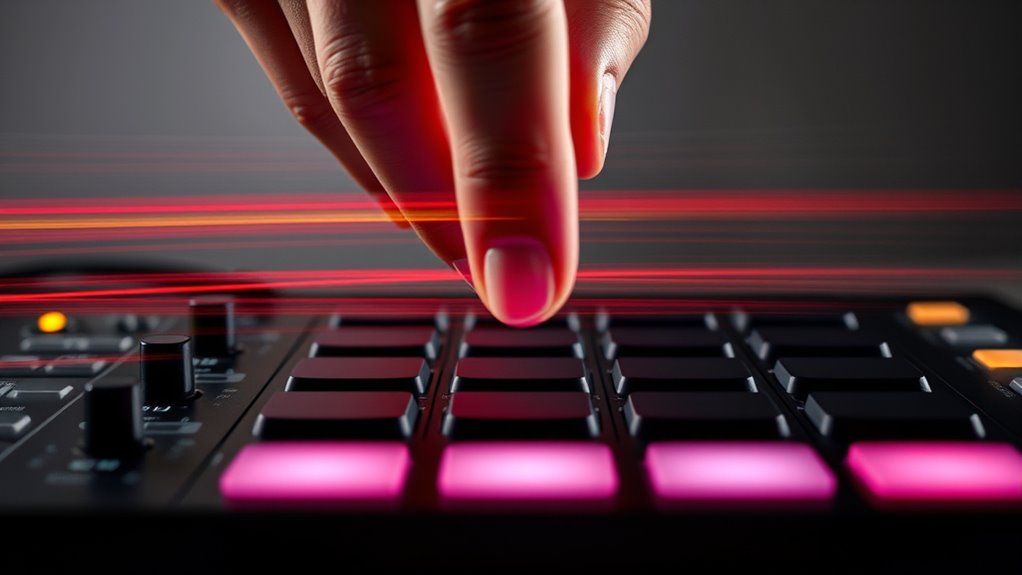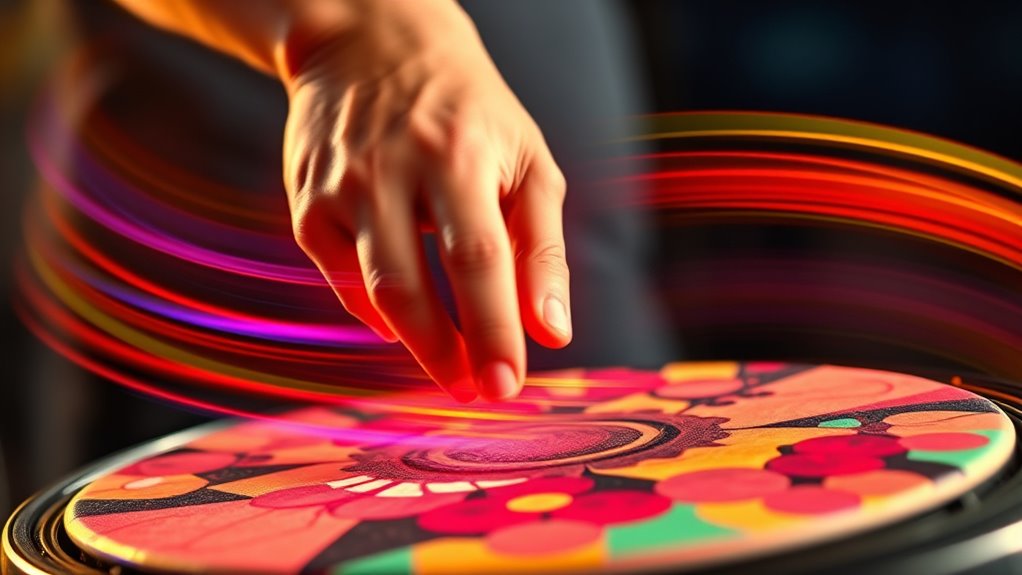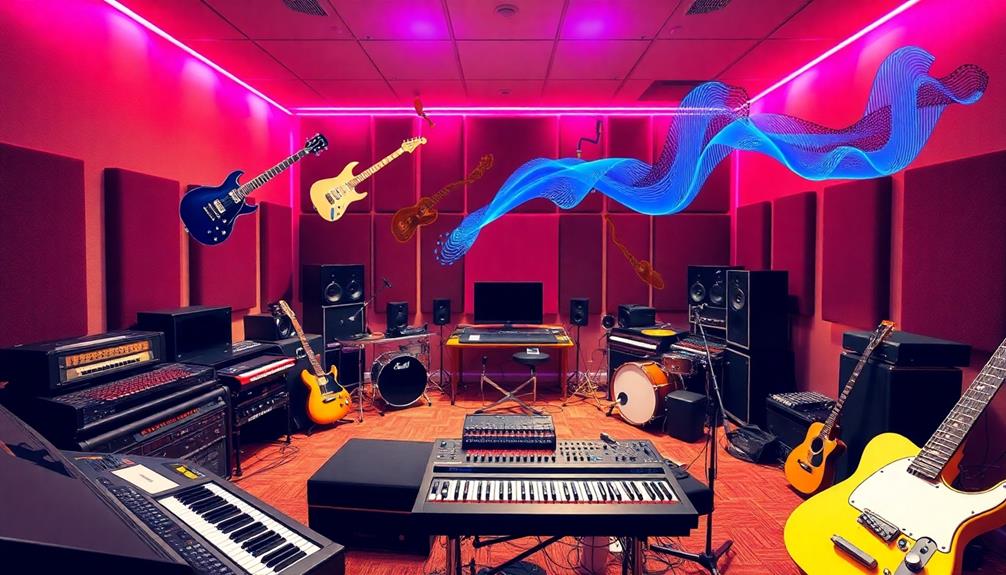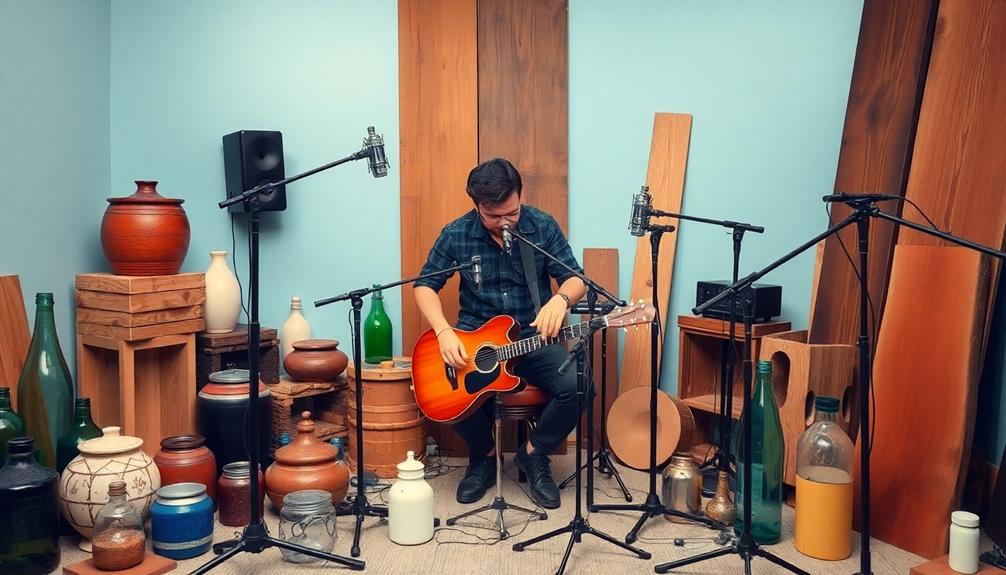To keep pads alive with dynamic noise, focus on using movement through modulation and automation. Vary parameters like filter cutoff, pitch, or reverb decay over time to create evolving textures. Layer different noise sounds and pan them across stereo space, adding movement and depth. Incorporate velocity and aftertouch to make each hit feel organic and reactive. Mastering these techniques will help you craft vibrant, lively soundscapes that stay engaging—continues with tips to energize your pads even further.
Key Takeaways
- Automate filter sweeps and effects to create evolving tonal qualities in pad sounds.
- Use modulation sources like LFOs and envelopes to add movement and texture variation.
- Layer multiple noise textures with dynamic panning to generate immersive, shifting soundscapes.
- Incorporate velocity and aftertouch controls to introduce organic, reactive changes during performance.
- Automate reverb decay and other effects for evolving spatial characteristics that keep pads lively.
The Power of Modulation and Expression

Modulation and expression are essential tools that give your noise performances depth and emotional impact. By harnessing expressive control, you can shape your sound to evoke specific feelings or atmospheres. Parameter automation allows you to dynamically change various aspects of your sound, such as filter cutoff, pitch, or amplitude, over time. This process adds movement and life to static sounds, making each performance unique. Using modulation sources like LFOs or envelopes, you can subtly or dramatically alter your noise textures. These techniques enable you to craft evolving soundscapes that keep your audience engaged. Mastering expressive control and parameter automation transforms simple noise into a compelling, emotionally resonant experience, helping you convey your artistic intent with precision and nuance.
Incorporating Velocity and Aftertouch Dynamics

Incorporating velocity and aftertouch dynamics into your noise performances adds an essential layer of expressiveness that responds directly to your playing. Velocity layering allows you to vary the intensity of your sound, making each hit or movement feel more alive. By controlling how hard you press, you can create nuanced textures that shift dynamically. Aftertouch modulation further enhances this expressiveness by letting you manipulate parameters like filter cutoff or pitch after the initial strike, adding subtle variations. Use velocity to emphasize certain hits and aftertouch to introduce evolving modulations, giving your noise textures a more organic and reactive feel. These techniques help your pads breathe with movement, making your performances more engaging and emotionally resonant. Additionally, understanding and effectively utilizing sound manipulation techniques can significantly elevate your expressive capabilities.
Automating Parameters for Evolving Textures

By automating parameters, you can create evolving textures that transform over time, adding depth and movement to your noise performances. Using techniques like velocity modulation and parameter automation, you control how sound characteristics shift dynamically. Here are some ways to get started:
- Map parameter automation to your MIDI or control voltage signals for smooth, continuous changes.
- Use velocity modulation to influence parameters like filter cutoff or amplitude, making textures respond to your playing intensity.
- Automate effects parameters, such as reverb decay or distortion levels, to evolve the sound organically.
- Combine multiple automations for complex, layered textures that shift unpredictably over time.
- Incorporating personal development principles like mindfulness can enhance your focus, helping you intuitively respond to the evolving textures during performances.
This approach keeps your noise lively and engaging, ensuring every performance feels alive and immersive.
Layering and Panning Techniques for Movement

Layering multiple noise textures and panning them across the stereo field creates a dynamic sense of movement that keeps your soundscape engaging. Use parameter modulation to subtly vary each layer’s panning position over time, adding unpredictability and depth. Experiment with stereo panning, moving textures from left to right or in circular patterns, to give your pads a lively, immersive feel. By modulating the pan positions and adjusting the levels of each layer, you can craft a sense of evolving motion that breathes life into static sounds. Keep the panning movements smooth and deliberate to avoid distraction, ensuring the noise layers complement each other harmoniously. Incorporating dynamic modulation techniques can further enhance the movement and complexity of your layers. This approach transforms simple layers into a vibrant, moving sonic landscape that maintains listener interest.
Practical Tips for Maintaining a Vibrant Sound Palette

Maintaining a vibrant sound palette requires intentional variation and careful attention to detail. To keep your pads lively, experiment with filter sweeps to subtly shift tonal qualities, making your sounds evolve naturally. Use reverb tails creatively—dampening or extending them can add depth and movement. Here are some practical tips:
- Automate filter sweeps during passages for dynamic shifts.
- Adjust reverb decay times to emphasize or soften reverb tails.
- Layer different pad textures with varying filter movements.
- Use subtle modulation to prevent static, ensuring continuous interest.
- Incorporate sound quality considerations such as material and layering techniques to enhance overall vibrancy.
Frequently Asked Questions
How Does Movement Influence Emotional Impact in Sound Design?
Movement influences emotional impact in sound design by creating expressive modulation that evokes specific feelings. When you incorporate movement patterns, your sounds become more dynamic and engaging, helping listeners connect emotionally. You can use varying rhythms, shifts, or gestures to enhance the mood or tension. By actively shaping movement, you make your soundscapes more alive and emotionally resonant, guiding your audience through a richer auditory experience.
What Are Common Mistakes When Automating Parameters for Noise?
You’d think automating parameters for noise would be straightforward, but nope—automation pitfalls often bite back. You might forget to fine-tune parameter modulation, leading to jarring shifts instead of smooth progressions. Common mistakes include over-automation, causing chaos, or under-automation, making it dull. Keep an eye on your levels and timing, and avoid relying solely on automation presets. A little subtlety goes a long way in maintaining organic, lively noise textures.
How Can I Synchronize Pad Movement With Other Instruments?
To synchronize pad movement with other instruments, focus on visual sync and rhythmic alignment. You can achieve this by matching your pad’s movement patterns to the beat or tempo of your tracks, using visual cues like waveforms or metronomes. Adjust timing settings so movements align precisely with rhythm changes, ensuring everything feels cohesive. This technique helps create a more dynamic and integrated sound, making your performance more compelling and synchronized.
Are There Specific Hardware Tools Recommended for Dynamic Noise Creation?
When exploring hardware tools for dynamic noise creation, you should focus on hardware synths known for rich modulation techniques. These synths allow you to manipulate noise elements in real-time, giving your sounds movement and life. Look for models with extensive modulation options, like the Moog Mother-32 or Korg Minilogue XD. They enable you to craft evolving noise textures, perfectly aligning with your goal of using movement to keep pads vibrant and dynamic.
How Does Listener Perception Change With Varying Movement Techniques?
A picture is worth a thousand words, and in sound, movement shapes perception. As you vary movement techniques, your listener’s perception shifts—making the experience more dynamic and engaging. You can create tension, release, or surprise, which keeps their attention sharp. Your changes in rhythm or motion influence how they perceive the sound’s energy and depth, ultimately boosting listener engagement and making your music more lively and compelling.
Conclusion
Just like a skilled painter brings life to a blank canvas, you can keep your pads vibrant by embracing movement and modulation. Think of your sound as a living organism, constantly evolving with velocity, aftertouch, and automation. Don’t let your pads become static—channel the spirit of the great innovators who transformed silence into symphony. Keep experimenting, layering, and panning. With these techniques, your sound will breathe, pulse, and stay forever alive—an eternal dance of dynamic noise.










